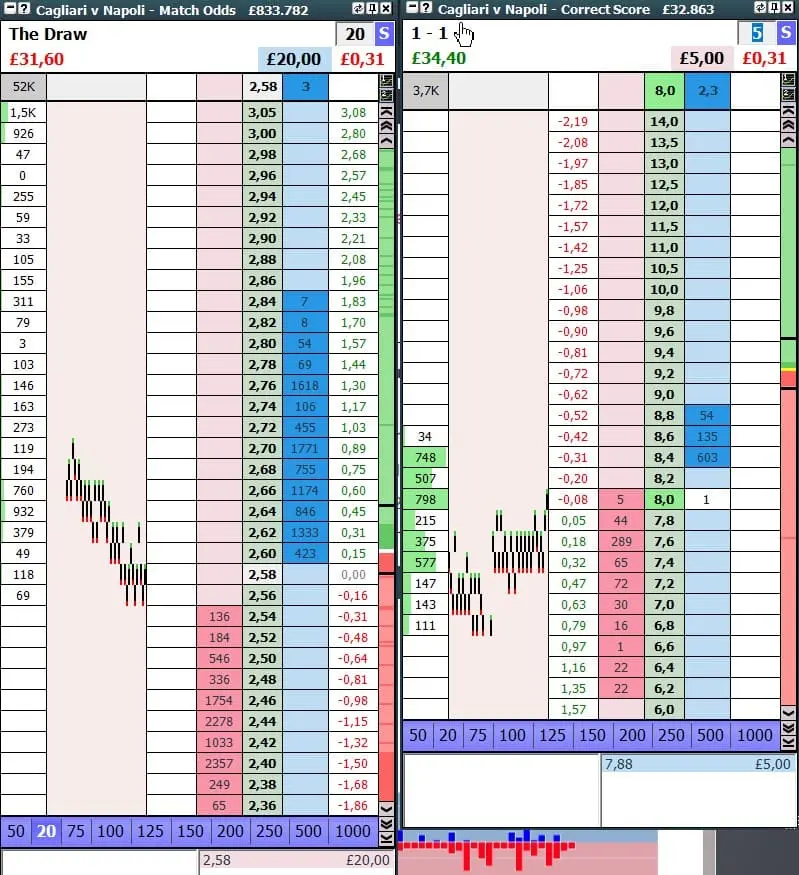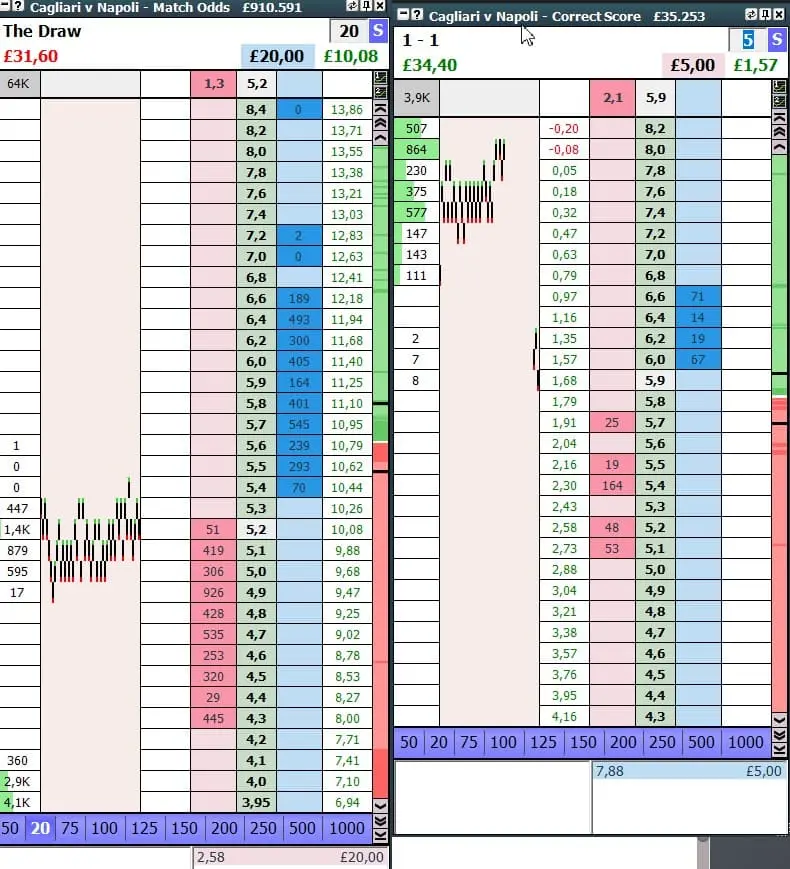Laying the draw with 1-1 result insurance is a very interesting evolution of the basic profit-enhancing strategy. Lay the draw with this coverage must be done exclusively live for several reasons that we will analyse. The big advantage of this mode is that you do not have to close the draw bet after the first goal but can cash out on the results of 0-2; 2-0; 2-1 and 1-2.
In this strategy you go live when the odds of the draw drop considerably but the odds of the 1-1 remain in a narrow range: you save on the cover. Covering the 1-1 result allows you to profit 50% more than just the lay the draw.
When to lay the draw
It is advisable to go for laying the live draw around the 30-35 minute mark of the first half or at the end of the half if the result remains 0-0. The odds of the draw should be at least around 3.00 and no higher. If the odds are higher, the liability coverage is higher. The best odds should be in the 2.80 - 2.50 range. As soon as you have lay on the draw, you have to ensure the 1-1 result of the entire liability of the bet. One must first bank and then hedge because in the meantime the goal might come and one can green up without the cost of hedging, which has an advantage anyway.
Before implementing the betting exchange strategy, one must analyse the exact results of both teams: there must have been few or no 0-0.
If you notice the difference between the 0-0 half-time and final matches of any league or between the direct matches of the two teams are remarkable. That is, about 30% of the matches (depending on the league) end 0-0 first half, while it becomes 6-8% final. Before executing the strategy, one must look at the match or the graph of the match with the help of scoretrend. If the match is close and there is a favourite then you can bank it. If it is a top clash or match with few chances or few shots then one must adopt another methodology.
The strategy becomes really top if you use the lay X indicated by the draw balance of scoretrend's Asianodds. The draw balance indicator in lay mode signals if there are any inconsistencies between the Asian odds, handicaps etc and the statistics. As you can see for yourself, the matches that end 0-0 reported by the lay DB predictions can be counted on the fingers of one hand and usually many goals are scored.
You could bet the lay the draw at around odds of 3.00 without hedging. In the event of a goal you can cash out: when the odds of the draw fall and the odds of the 1-1 correct result start to rise then you hedge the draw. In this way you take the lay the draw ahead without having to cash out.
To reduce the risk even further the dynamic line stats come to the rescue, which allow you to see where both teams score or concede the most goals. Once the time frame has been identified, the draw bet can be placed. The timing of the entry is very important to reduce the risk.
Below is an example image of the live lay the draw at the end of the first half and simultaneous coverage of the 1-1 result. As you can see the coverage is slightly higher. For simplicity and to be quicker, I have used a non-accurate amount which allows a small profit even in the case of a 1-1 result.

After the first goal, which occurred in the 65th minute in this case of the favourite team, you could double cash out. At this time you had a profit of around 10.44 euros on the draw and a profit of 1.57 on the 1-1 result.
You can see the actual situation in the image below.

Advantages and disadvantages of insurance 1-1
Hedging any strategy is always a trade-off between risk and return. If you hedge one result, you obviously remain uncovered elsewhere. The d lay the draw k with 0-0 hedging must be done pre-match and on matches between two teams that are balanced and score towards the end. In this case you are 'uncovered' if the goal comes quickly and the cash out on the draw does not compensate for the cost of the cover.
Ensure the result of 1-1 allows you to profit around 50% more than with the classic lay the draw. With this hedge you can in fact stay in the market after the goal because you are hedged on the 1-1 result. When the result is cleared you can still decide to cash out on the draw and also on the 1-1 result. Obviously if the goal is scored in the last 5-10 minutes you don't have a green up on the 1-1 result but the cash out on the draw is considerably higher and compensates for the slight loss: everything is obviously compensated! The odds move proportionally and symmetrically on all outcomes.
You only have a dry loss if the match ends on the exact result of 0-0. It is advisable to use your stake to cover the draw and the 1-1 cover. Covering the liability costs about 15% but brings about 50% more profit.
50% higher profit than banking only the draw.
You only cash out on the result of 2-0; 0-2; 2-1 and 1-2
On the result of 1-1 (more likely) you are in void
You can decide to cash out even after a goal and you are in profit.
If the match ends 0-0 you lose the draw bet and the 1-1 insurance
You should do this strategy preferably live and not pre-match (advice)
When to cash out
As already explained it is recommended to cash out on the results of 0-2, 2-0, 2-1 and 1-2. Sports trading is a methodology that allows you to have a direct interaction on the match, and based on the course of the match you can decide how to behave. For example, if after the first goal the team that has been at a disadvantage attacks a lot and looks like it could draw, then you can decide to cash out. The profit is slightly higher than that of the classic draw bet. This decision should only be made if there is a strong motivation during the live game.
In other cases, one must leave the bet open and close strictly on the results mentioned above. Once you are on the result of 2-0, 0-2, 2-1 or 1-2, you must close your open position, as on 2-2 you would lose both your bet and your cover.
Strategy video guide
In the video below, the lay X strategy with 1-1 insurance is explained in detail and how best to implement it during live play with the various scenarios and a real example. As you will see there are many variations and possibilities for hedging or exits.

Engineer Gianluca Landi has been a sports trader since 2007 and online with the first sports trading site and courses since 2011. Amazon bestselling author and founder of ScoreTrend.
- Category: Betting Exchange Strategies

